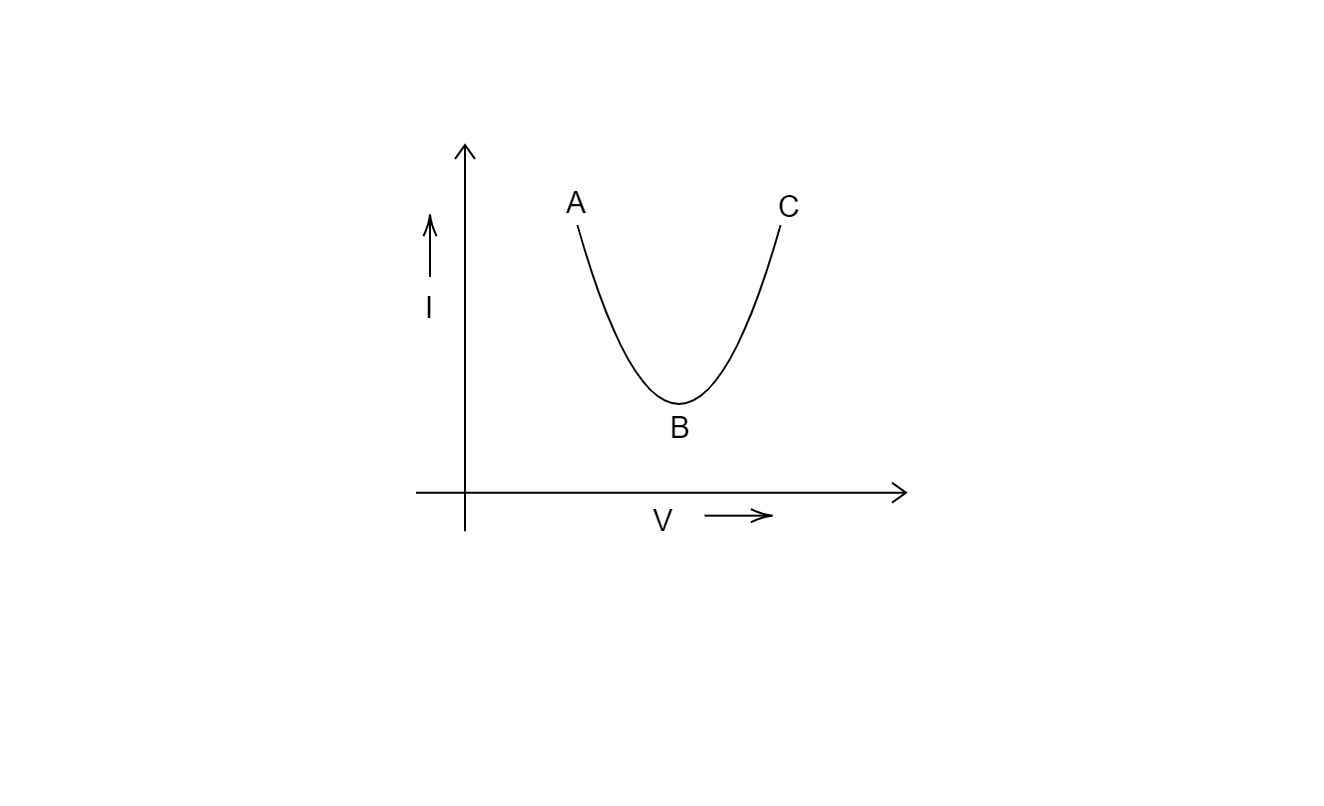
The current-voltage graph for a device is shown in figure. The resistance is negative in region:

(a) AB
(b) BC
(c) ABC
(d) None of these

Answer
565.5k+ views
Hint: Resistance is given as $R = \dfrac{V}{I}$. Here the slope gives us the value $m = \dfrac{{\Delta I}}{{\Delta V}} = \dfrac{{{I_2} - {I_1}}}{{{V_2} - {V_1}}}$which is nothing but $m = \dfrac{1}{R}$. Therefore, try to figure for which part the slope will be negative.
Complete step by step answer:
From Ohm’s Law we have,
$
V = IR \\
\Rightarrow R = \dfrac{V}{I} \\
$
And the graph is I vs V so the slope will be,
$m = \dfrac{{\Delta I}}{{\Delta V}} = \dfrac{{{I_2} - {I_1}}}{{{V_2} - {V_1}}}$
On further simplification,
\[R = \dfrac{1}{m}\]
Now from the graph we see that for part AB the slope is negative, for point B slope is zero and for part BC the slope is positive. Therefore, the part for which the resistance is negative is AB.
The correct answer is option A.
Note:Be careful in evaluating the slope. Read the axes carefully whether V is on x-axis or y-axis. Many times students evaluate slope m=R=V/I in a hurry. Well the answer remains the same and correct in case of multiple choice. But in case of subjective questions, marks will be deducted.
Complete step by step answer:
From Ohm’s Law we have,
$
V = IR \\
\Rightarrow R = \dfrac{V}{I} \\
$
And the graph is I vs V so the slope will be,
$m = \dfrac{{\Delta I}}{{\Delta V}} = \dfrac{{{I_2} - {I_1}}}{{{V_2} - {V_1}}}$
On further simplification,
\[R = \dfrac{1}{m}\]
Now from the graph we see that for part AB the slope is negative, for point B slope is zero and for part BC the slope is positive. Therefore, the part for which the resistance is negative is AB.
The correct answer is option A.
Note:Be careful in evaluating the slope. Read the axes carefully whether V is on x-axis or y-axis. Many times students evaluate slope m=R=V/I in a hurry. Well the answer remains the same and correct in case of multiple choice. But in case of subjective questions, marks will be deducted.
Recently Updated Pages
A man running at a speed 5 ms is viewed in the side class 12 physics CBSE

The number of solutions in x in 02pi for which sqrt class 12 maths CBSE

State and explain Hardy Weinbergs Principle class 12 biology CBSE

Write any two methods of preparation of phenol Give class 12 chemistry CBSE

Which of the following statements is wrong a Amnion class 12 biology CBSE

Differentiate between action potential and resting class 12 biology CBSE

Trending doubts
What are the major means of transport Explain each class 12 social science CBSE

Which are the Top 10 Largest Countries of the World?

Draw a labelled sketch of the human eye class 12 physics CBSE

Explain sex determination in humans with line diag class 12 biology CBSE

Explain sex determination in humans with the help of class 12 biology CBSE

Differentiate between homogeneous and heterogeneous class 12 chemistry CBSE




